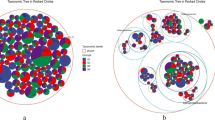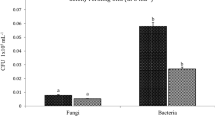Abstract
The composition of the bacterial community associated with plant roots is influenced by a variety of plant, environmental factors and also management practices. Our study aimed at detecting the root associated bacterial communities of Chinese cabbage under different fertilization regimes using cultivation dependent methods. The cultivable population was studied using plate count assay, fatty acid methyl ester (FAME) analysis and carbon substrate utilization␣(SU)using BIOLOG™ plates. Taxonomical identification of the isolates by FAME resulted in about 83% identification and they represented 9 and 14 different known bacterial genera from the rhizosphere and root interior respectively from Proteobacteria (α, β, and γ), firmicutes (actinobacteria and the Bacillus groups) and Bacteroidetes. Pseudomonas and Bacillus were associated with the plants grown under all the fertilized conditions and actinobacteria could be observed only in rhizosphere of plants grown on unfertilized plots. FAME and BIOLOG profiles of the rhizosphere and endophytic isolates could separate them with reference to fertilization. Principal component analysis (PCA) on the BIOLOG SU revealed that the isolates were metabolically dissimilar. The diversity, as revealed by the diversity indices was greater among the isolates obtained from unfertilized samples than that of fertilized ones. The isolates analyzed for different traits related to plant growth promotion revealed differences between rhizosphere and endophytic isolates and also with reference to the treatments. The highest percentage of phosphate solubilizing bacteria (PSB) and 1-aminocyclopropane-1-carboxylic acid (ACC) utilizers was recorded in chemical fertilizer treated samples, followed by the organic fertilizer treated. The results from this study indicate that fertilizers have an effect on the root associated bacterial communities of Chinese cabbage and also on their physiological characteristics related to plant growth promotion.
Similar content being viewed by others
Abbreviations
- ACC:
-
1-aminocyclopropane-1-carboxylic acid
- ARA:
-
acetylene reduction assay
- AWCD:
-
average well color development
- CAS:
-
chrome azurol S
- CFU:
-
colony forming units
- FAME:
-
fatty acid methyl ester
- IAA:
-
indole-3-acetic acid
- PCA:
-
principal components analysis
- PGPR:
-
plant growth promoting rhizobacteria
- PBS:
-
phosphate buffered saline
- PSB:
-
phosphate solubilizing bacteria
- SIM:
-
similarity
- SU:
-
substrate utilization
- TSA:
-
tryptic soy agar
References
Asghar HN, Zahir ZA, Arshad M, Khaliq A (2002) Relationship between in vitro production of auxins by rhizobacteria and their growth-promoting activities in Brassica juncea L. Biol Fertil Soils 35:231–237
Atlas RM, Bartha R (1998) Microbial ecology: fundamental and applications. Benjamin/Cummings Publishing CO., Menlo Park, CA, p 593
Axelrood PE, Chow ML, Arnold CS, Lu K, McDermott JM, Davies J (2002) Cultivation-dependent characterization of bacterial diversity from British Columbia forest soils subjected to disturbance. Can J Microbiol 48:643–654
Baldani VLD, Döbereiner J (1980) Host-plant specificity in the infection of cereals with Azospirillum spp. Soil Biol Biochem 12:433–439
Bano N, Musarat J (2003) Isolation and characterization of phorate degrading soil bacteria of environmental and agronomic significance. Lett Appl Microbiol 36: 349–353
Belimov AA, Safronova VI, Sergeyeva TA, Egorova TN, Matveyeva VA, Tsyganov VE, Borisov AY, Tikhonovich IA, Kluge C, Preisfeld A, Dietz KJ, Stepanok VV (2001) Characterization of plant-growth promoting rhizobacteria isolated from polluted soils and containing 1-aminocyclopropane-1-carboxylate deam inase. Can J Microbiol 47:642–652
Benizri E, Amiaud B (2005) Relationship between plants and soil microbial communities in fertilized grasslands. Soil Biol Biochem 37:2055–2064
Cavigelli MA, Robertson GP, Klug MJ (1995) Fatty acid methyl ester (FAME) profiles as measures of soil microbial community structure. Plant Soil 170:99– 113
Chabot R, Antoun H, Cescas MP (1996) Growth promotion of maize and lettuce by phosphate solubilizing Rhizobium leguminosarumi biovar phaseoli. Plant Soil 184:311–321
Dell’Amico E, Cavalca L, Andreoni V (2005) Analysis of rhizobacterial communities in perennial Graminaceae from polluted water meadow soil, and screening of metal-resistant, potentially plant growth-promoting bacteria. FEMS Microbiol Ecol 52:153–162
Ditchfield J (1993) Cholera, plankton blooms, and ballast water. Glob Biodivers (Can Museum Nat) 3(3):17–18
Donate-Correa J, León-Barrios M, Pérez-Galdona R (2004) Screening for plant growth-promoting rhizobacteria in Chamaecytisus proliferus (tagasaste), a forage tree-shrub legume endemic to the Canary Islands. Plant Soil 266:261–272
Dunfield EF, Germida JJ (2001) Diversity of bacterial communities in the rhizosphere and root interior of field-grown genetically modified Brassica napus. FEMS Microbiol Ecol 38:1–9
Dworkin M, Foster J (1958) Experiments with some microorganisms which utilize ethane and hydrogen. J Bacteriol 75:592–601
Garland JL (1996) Patterns of potential C source utilization by rhizosphere communities. Soil Biol Biochem 28:223–230
Garland JL, Mills AL (1991) Classification and characterization of heterotrophic microbial communities on the basis of pattern of community-level sole-carbon-source utilization. Appl Environ Microbiol 57: 2351–2359
Germida JJ, Siciliano SD (2001) Taxonomic diversity of bacteria associated with the roots of modern, recent and ancient wheat cultivars. Biol Fertil Soils 33: 410–415
Germida JJ, Siciliano SD, de Freitas JR, Seib AM (1998) Diversity of root-associated bacteria associated with field-grown canola (Brassica napus L.) and wheat (Triticum aestivum L.). FEMS Microbiol Ecol 26:43–50
Glick BR, Jacobson CB, Schwarze MMK, Pasternak JJ (1994) 1-Aminocyclopropane-1-carboxylate deaminase mutants of plant growth promoting rhizobacterium Pseudomonas putida GR12-2 do not stimulate canola root elongation. Can J Microbiol 40:911–915
Glimm E, Heuer H, Engelen B, Smalla K, Bakshan H (1997) Statistical comparisons of community catabolic profiles. J Microbiol Meth 30:71–80
Grayston SJ, Wang S, Campbell CD, Edwards AC (1998) Selective influence of plant species on microbial diversity in the rhizosphere. Soil Biol Biochem 30:369–378
Grunwald NJ, Goodwin SB, Milgroom MG, Fry WE (2003) Analysis of genotypic data for populations of microorganisms. Phytopathology 93:738–746
Hallmann J, Quadt-Hallmann A, Mahaffee WF, Kloepper JW (1997) Bacterial endophytes in agricultural crops. Can J Microbiol 43:895–914
Hardy RWF, Holsten RD, Jackson EK, Burns RC (1968) The acetylene ethylene assay for N2 fixation. Laboratory and field evaluation. Plant Physiol 43:1185–1207
Hiltner L (1904) Über neuere Erfahrungen und Probleme auf dem Gebiet der Bodenbackteriologie und unter besonderer BerÜcksichtigung der GrÜndÜngung und Brache. Arbeiten Deutscher Landwirtschafts Gesellschaft 98:59–78
Innes L, Hobbs PJ, Bardgett RD (2004) The impact of individual plant species on rhizosphere microbial communities in soils of different fertility. Biol Fertil Soils 40:7–13
Kim CW, Kecskés ML, Deaker RJ, Gilchrist K, New PB, Kennedy IR, Kim SH, Sa TM (2005) Wheat root colonization and nitrogenase activity by Azospirillum isolates from crop plants in Korea. Can J Microbiol 51:948–956
Kloepper JW, Lifshitz R, Zablotowicz RM (1989) Free living bacterial inocula for enhancing crop productivity. Trends Biotechnol 7:39–44
Larkin RP (2003) Characterization of soil microbial communities under different potato cropping systems by microbial population dynamics, substrate utilization, and fatty acid profiles. Soil Biol Biochem 35: 1451–1456
Li J, Ovakim DH, Charles TC, Glick BR (2000) An ACC deaminase minus mutant of Enterobacter cloacae UW4 no longer promotes root elongation. Curr Microbiol 41:101–105
Lilley AK, Fry JC, Bailey MJ, Day MJ (1996) Comparison of aerobic heterotrophic taxa isolated from four root domains of mature sugar beet (Beta vulgaris). FEMS Microbiol Ecol 21:231–242
Lima JA, Nahas E, Gomes AC (1996) Microbial populations and activities in sewage sludge and phosphate fertilizer-amended soil. Appl Soil Ecol 4:75–82
Lowry OH, Rosebrough NJ, Farr AL, Randall RJ (1951) Protein measurement with folin-phenol reagent. J Biol Chem 193:265–275
Mantelin S, Touraine B (2004) Plant growth-promoting bacteria and nitrate availability impacts on root development and nitrate uptake. J Exp Bot 55:27–34
Martyniuk S, Wagner GH (1978) Quantitative and qualitative examination of soil microflora associated with different management systems. Soil Sci 125:343–350
Misko AL, Germida JJ (2002) Taxonomic and functional diversity of pseudomonads isolated from the roots of field-grown canola. FEMS Microbiol Ecol 42:399–407
Nicol GW, Glover A, Prosser JI (2003) The impact of grassland management on archaeal community structure in upland pasture rhizosphere. Environ Microbiol 5:152–162
Olsson S, Alstrom S, Persson P (1999) Barley rhizobacterial population characterized by fatty acid profiling. Appl Soil Ecol 12:197–204
Penrose DM, Glick BR (2001) Levels of ACC and related compounds in exudate and extracts of canola seeds treated with ACC deaminase containing plant growth-promoting bacteria. Can J Microbiol 47:368–372
Pikovskaya RI (1948) Mobilization of phosphorus in soil in connection with vital activity of some microbial species. Microbiologia 17:362–370
Ruiz Palomino M, Lucas Garcıa JA, Ramos B, Gutierrez Manero FJ, Probanza A (2005) Seasonal diversity changes in alder (Alnus glutinosa) culturable rhizobacterial communities throughout a phenological cycle. Appl Soil Ecol 29:215–224
SAS Institute Inc. (2004) SAS 9.1®. Companion for Windows SAS, SAS Institute Inc, Cary, NC
Sasser M (1990) Identification of bacteria through fatty acid analysis. In: Klement S, Rudolf K, Sands D, (Eds.), Methods in phytobacteriology. Akademiai Kiado, Budapest. pp 199–204
Sasser M (2001) (revised from 1990) Identification of bacteria by gas chromatography of cellular fatty acids. Technical Note # 101
Schmalenberger A, Tebbe CC (2002) Bacterial community composition in the rhizosphere of a transgenic, herbicide-resistant maize (Zea mays) and comparison to its non-transgenic cultivar Bosphore. FEMS Microbiol Ecol 40:29–37
Schwyn B, Neilands J (1987) Universal chemical assay for the detection and determination of siderophores. Anal Chem 160:47–56
Siciliano SD, Germida JJ (1999) Taxonomic diversity of bacteria associated with the roots of field grown transgenic Brassica napus cv. Quest, compared to the non-transgenic B. napus cv. Excel and B. rapa cv. Parkland. FEMS Microbiol Ecol 29:263–272
Silva PD, Nahas E (2002) Bacterial diversity in soil in response to different plants, phosphate fertilizers and liming. Brazilian J Microbiol 33:304–310
Sobral JK, Araujo WL, Mendes R, Geraldi IO, Pizzirani-Kleiner AA, Azevedo JL (2004) Isolation and characterization of soybean-associated bacteria and their potential for plant growth promotion. Environ Microbiol 6:1244–1251
Sturz AV, Christie BR, Nowak J (2000) Bacterial endophytes: potential role in developing sustainable systems of crop production. Crit Rev Plant Sci 19: 1–30
Torsvik V, Goksotr J, Daae FL (1990) High diversity in DNA of soil bacteria. Appl Environ Microbiol 56:782–787
Zaidi A, Khan MS, Amil MD (2003) Interactive effect of rhizotrophic microorganisms on yield and nutrient uptake of chickpea (Cicer arietinum L.). Eur J Agron 19:15–21
Acknowledgements
We thank the anonymous referees for their critical review of the manuscript. This work was supported by grants from the Korea Research Foundation, Republic of Korea through PhD fellowship to S. Poonguzhali and invitation programs for foreign Scientists & Engineers to M. Madhaiyan.
Author information
Authors and Affiliations
Corresponding author
Rights and permissions
About this article
Cite this article
Poonguzhali, S., Madhaiyan, M. & Sa, T. Cultivation-dependent characterization of rhizobacterial communities from field grown Chinese cabbage Brassica campestris ssp pekinensis and screening of traits for potential plant growth promotion. Plant Soil 286, 167–180 (2006). https://doi.org/10.1007/s11104-006-9035-1
Received:
Accepted:
Published:
Issue Date:
DOI: https://doi.org/10.1007/s11104-006-9035-1




